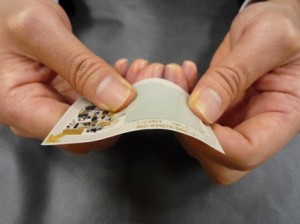
NEC Corporation announced on March 5 the development of a new ultra-thin, 0.3mm thick, organic radical battery (ORB) that is compatible with standard IC cards of 0.76mm thickness. These new, 0.3mm batteries are less than half the thickness of existing units.
The size reduction is accomplished by using printing technologies to integrate circuit boards with batteries. As a result, IC cards embedded with these batteries can be used for a wide range of functions, including displays, transmission and advanced encryption processing. Conventional ORB‘s have a thickness of 0.7mm which makes them difficult to combine with IC cards of standard 0.76mm thickness.
An Organic Radical Battery uses an organic radical compound for its electrode active material. A gel-like and flexible electrode is formed by impregnating a composite positive electrode. The positive electrode consists of an organic radical compound and carbon fibers with electrolyte. Charging and discharging of the battery is done by oxidation-reduction reaction at the radical part.
One of the key features NEC has identified with the newly developed batteries is the 0.3mm thickness that is realized through integration with circuit boards. The batteries are externally wrapped with a polymer film of 0.05mm thickness, unlike conventional batteries that use an aluminum laminate as external material that can be up to 0.2mm thick.
The thickness of only 0.3mm is achieved by using printing technologies that enable negative electrodes to be directly formed on circuit boards. This is created in combination with separators (insulation) on the negative electrodes and laminated radical polymer cathodes.
NEC prototyped a 3 x 3cm battery with a thickness of 0.3mm and a capacity of 3mAh, and confirmed that the battery has an output density of 5kW/L. When fully charged, the prototype battery can either refresh a screen 2,000 times, set off a flash 360 times in succession or transmit location information 35 times. NEC also conducted a charge-discharge cycle test that indicates the batteries will maintain 75% of their initial charge capacity after 500 cycles. This makes the performance equivalent to standard lithium-ion batteries for mobile phones.
